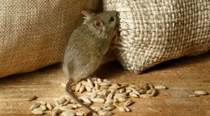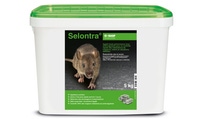BASF Professional & Specialty Solutions
The key to a successful and sustainable rodent control programme

Every farmer knows that controlling rats and mice isn’t as simple as picking the strongest bait off the shelf and leaving it down for rodents to consume. In fact, there are a whole host of factors that should be considered!
Before even reaching for a rodenticide, the best practice is to first carry out environmental management such as proofing buildings and tidying the site, and then explore non-chemical control methods, whether it is utilising natural predators, or using instant-kill traps.
But when chemical control is required, many don’t realise that bait rotation is vital to long-term success. Laurence Barnard, Country Business Manager for BASF’s Professional & Specialty Solutions, comments:
“Rodenticide resistance is a phenomenon that has been causing increasing issues across the country, particularly in certain areas such as Greater Manchester or South Central England. Much like how humans can become resistant to certain antibiotics, rodents have developed resistance to the active ingredients in first-generation anticoagulants and some second-generation anticoagulants, particularly difenacoum and bromadiolone.”
To combat any potential resistance problem, farmers should be utilising rodenticides that contain either cholecalciferol or flocoumafen as the active ingredient, as there is no known resistance to either active. Ideally, usage should be rotated between the two to prevent any possible future resistance from developing.
In addition, although more prevalent in mice, rodents can become bored of the rodenticide on offer and search for alternative food sources. Switching between two highly palatable rodenticides will ensure they remain an attractive food source, encouraging rodents to continue feeding.
Laurence adds: “Of course, the rodenticide used must be highly palatable and potent. However, product stewardship is essential to ensure the future-proofing of effective solutions on the market and safeguard the pest management toolbox."


So, how often should farmers be rotating their baits? It is recommended that rodenticides should be changed every three to four months as best practice, with a minimum of every six months, to ensure a long-term, successful pest management programme.
Ideally, farmers should switch between rodenticides with a different active ingredient to ensure an effective treatment. BASF offers a range of resistance-busting rodenticides, such as the award-winning cholecalciferol-active Selontra® and the highly powerful flocoumafen-active in Storm® Secure and Neosorexa® Plus Blocks.
Neither Selontra® nor the Storm® products have any known resistance, and both offer a fast, effective solution to allow farmers to rotate their baits throughout the year without worrying about unknowingly contributing to rodenticide resistance or behavioural issues.
Top tips for effective environmental management
The best way to deal with rodents is to prevent them from becoming active in the first place, so farmers should be “rodent-proofing” their sites now to protect profits this winter.
Particularly at this time of year when temperatures begin to dip, rats and mice will be looking for warm harbourage where food sources are readily available, making buildings where animal feed or crops are stored very appealing. There are a few very simple preventative steps farmers can take to deter the pests:
1. Keep site clean and tidy. It may seem simple, but keeping sites tidy should become a regular part of any farmer’s maintenance routine. Keep pallets and sacks to a minimum as these make for the perfect harbourage, and remove any rubbish or unwanted stores of straw and hay as soon as possible to give rats and mice less time to move in.
2. Cut back vegetation and bushes around buildings. Rats have a fear of open spaces, so by trimming back shrubbery by at least one metre around all buildings on land, they will be less inclined to cross an open yard to enter a building. This also allows farmers to readily observe any rat burrows, and gives natural predators more chance of spotting the pests too.
3. Rodent-proof buildings. Rodents can fit through surprisingly small openings – mice can get through gaps of 6mm and rats can get through gaps of 10mm - so carefully inspect any buildings, stores or outhouses for wear and tear in walls, piping, doors and windows. Use a hardwearing material like metal sheeting to prevent rodents from re-entering through any compromised areas, as rats can chew through everything from wooden posts to dry walls.
4. Inspect the building for signs of an existing infestation. Visible footprints at ground level or on ledges, smear marks along ledges, walls or cables, damage in structures and equipment from gnaw marks, and droppings are all tell-tale signs of activity. Don’t forget to look at electrical wires and cabling – many farm fires have been caused by rodents chewing through electrical wires.
5. Store animal feed and green safely. Taking measures to prevent animal feed or grain from being contaminated and consumed is an important step. Rats can carry up to 45 dangerous diseases which can pose a serious health and safety issue. Ensure the stores are thoroughly cleaned and inspect every inch for any entry points or damage where rodents may enter and clean up any food spills immediately.
6. Monitor for activity. Using a Monitoring Paste will help farmers spot rodent activity before an infestation can get out of hand. It also means any rodents in the area will become more familiar with the object, reducing neophobia when the monitoring baits are replaced with rodenticide. An alternative monitoring method is to leave a patch of sand along a suspected rat run overnight and look for paw marks in the sand the next day!
Related News
Information: Use biocide products carefully. Always read the label and product information before use.
